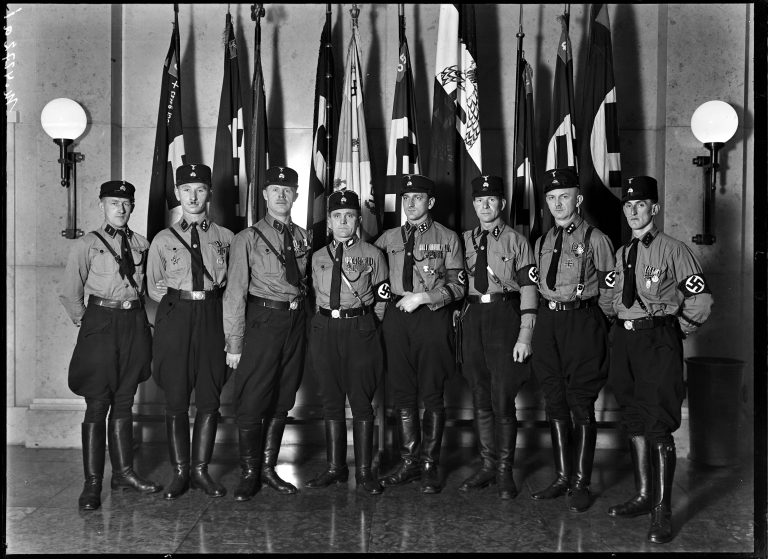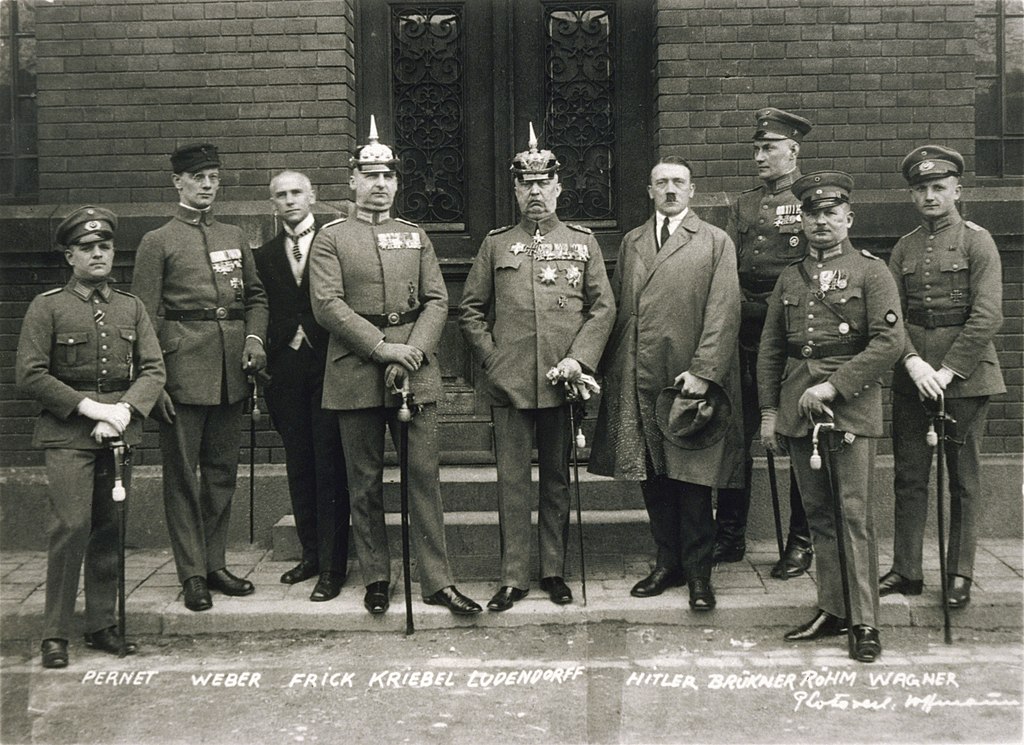Your cart is currently empty!
How Did Hitler Rise to Power?

Summary: It is only partially true that Hitler became a dictator overnight. He began his political career in 1919, after the First World War, and throughout the twenties and early thirties he gained popularity. In 1933 when he became the Chancellor of Germany, he quickly created a totalitarian dictatorship underneath the President’s nose, and by August of 1934, Hitler had secured his place as the Führer of Germany.
Post-WWI
Hitler’s persuasive abilities lied in his oratory skills, and his enthusiastic speeches were filled with propaganda. His speeches impressed Captain Karl Mayr, who recruited him to work as an undercover intelligence agent with the Bavarian military.
Hitler was given the title of “education officer.” His work was in “national thinking” courses, he was educating people on German history, nationalism, and the fear of communism. He gave speeches condemning Bolshevism and promoting German nationalism at the Munich barracks to influence the soldiers.
The Nazi Party was Hitler’s rebranding of the German Workers’ Party (DAP). Hitler was originally assigned to infiltrate the DAP to spy on their activities as part of his undercover intelligence work, but he became infatuated with the DAP and the founder, Anton Drexler.
Drexler was a nationalist, antisemite, anti-Marxist, and an anti-capitalist. He was drawn to Hitler, as well, inviting him to become a member of the DAP in September 1919, shortly after he infiltrated. Within a few months Hitler became the propagandist for the DAP, and quickly became one of the most influential people within the party.
The Nazi Party is Born
In February 1920 Hitler initiated the DAP’s name change. The German Worker’s Party became the National Socialist German Workers’ Party, Nationalsozialistische Deutsche Arbeiterpartei (NSDAP), the Nazi Party.
The Nazi Party created the 25 Point Program, a foundational piece of the Party, which intended to reinvent Germany by creating a nationalistic ethnostate. The 25 points included, but were not limited to, the following:
- Segregating Jewish people from society and striping them of their rights
- Colonizing land
- Redefining citizenship to exclude non-Aryan Germans
- Preventing immigration
- Nationalizing industries
- Controlling educational institutions
- Demanding freedom of religion—but only for those who would not endanger the state.
The Nazi Party called themselves “Nationalist” to garner support from right-leaning voters, and they called themselves “socialist” to garner support from left-leaning voters.
Nazism was not socialism, it was extreme fascism; it was a far-right, totalitarian, dictatorship that hinged on antisemitism and white supremacy. The DAP was a small group, and Hitler was the 55th member of the Party—but his membership card said 555th, because they began counting at 500 to appear like they had more support. When the DAP became the Nazi Party, they were still a fringe group which did not have much support, but the members became even more extreme.
At first the Nazi Sturmabteilung (SA) troops who marched through the streets in small protests were laughed at. They gained traction, membership in the party, and they spread their fascist rhetoric around enough to convince the general populace in their abilities to lead.
The Nazis were able to push their nationalistic and antisemitic rhetoric because there was much civil unrest in Germany. After WWI, Germany was required to pay roughly 33 billion dollars in reparations as part of the 1919 Treaty of Versailles, and that gravely affected their economy.

Nazi Schutzstaffel Leaders in their uniforms, CC BY-SA 4.0, National Archives Catalog via Wikimedia Commons
Germany’s Economic Depression
Inflation rates skyrocketed. The value of the mark (German dollar) fell exponentially. In 1918, 8.9 marks were equal to 1 US dollar, and in 1923 it had risen to 4.2 trillion marks to 1 US dollar. Money was essentially worthless, foreign aid stopped, unemployment rates soared, and they handed out “coupons” for small amounts of food staples.
Germans were poor, hungry, depressed, and angry. They brawled in the streets, political parties became extremists, and Nazis relied on the terrible state of the country for their own advantages. The Nazis promised jobs, better labor rights and working conditions, prosperity, remilitarization, and to end the communist influence on Germany.
Europe, as a whole, has a long history of antisemitism, which the Nazis exasperated. Germans wanted someone to blame for their issues, and Jewish people became the scapegoat.
- They blamed Jews for Germany losing in WWI and for the outcome of the Treaty of Versailles.
- They blamed Jews for Germany’s poverty and resented them because Jewish families retained their wealth.
- Then they blamed the Jews for the Wall Street Crash of 1929 because some bankers were Jewish, and the US recalled loans to Germany, causing their economy to fall more.
- And then when Ernst vom Rath, a German diplomat in Paris, was assassinated they blamed the entire Jewish population. The killer was a young Polish Jew named Herschel Grynszpan, he carried out the assassination because he was angry at the discrimination Jews were facing.
Hitler ousted the leadership in the Nazi Party by 1921, he had secured his place at the top. The Nazis gained traction by hosting rallies and meetings in beer halls, which were popular establishments for gathering to drink and be entertained.
The Coup D’état
On November 8 and 9, 1923, the Nazis attempted to seize control of the German government. The Munich Beer Hall Putsch was the failed coup d’etat to overthrow the Weimar Republic in Munich, Germany.
Nazis gathered in the Bürgerbräu Keller beer hall, Hitler fired a pistol at the ceiling and declared that the national revolution had begun. Their plan was to overthrow the Bavarian government and create a new one. Throughout the night they drank, discussed, argued, and designated Nazis to fulfill the new positions in the government after the coup.
In the morning on 9 November, they began marching, but the police thwarted the Nazis as they marched towards the Bavarian Defense Ministry. Over 2,000 Nazis participated, they were led by Hitler and his bodyguards. The ensuing brawl between the Nazis and about 130 police resulted in the death of fifteen Nazis, four policemen, and dozens of injuries.
Hitler evaded arrest; he was taken away to a safe house but was arrested two days afterwards. He was charged with high treason and imprisoned with some of his co-conspirators. Police raided their headquarters, their propagandist newspaper was banned, and a few Nazis were forced into hiding or else face arrest.
The trial lasted from 26 February to 1 April 1924. Hitler took sole responsibility for the Munich Beer Hall Putsch, and he explained his actions as a selfless obligation to the betterment of Germany. The lay judges supported the Nazis and the presiding judge, Georg Neitherdt, had to persuade them not to acquit Hitler.

After the Hitler-Ludendorff trial in Munich.
Left to right: Heinz Pernet, Dr. Friedrich Weber, Wilhelm Frick, Hermann Kriebel, Erich Ludendorff, Adolf Hitler, Wilhelm Brückner, Ernst Röhm, and Robert Wagner.
Photo by Heinrich Hoffmann, April 1924, CC BY-SA 3.0, German Federal Archive, via Wikimedia Commons
Their failed coup d’état prepared them for a successful one later.
Hitler and Rudolf Hess, his deputy, were sentenced to a five-year sentence, but after only eight months of Hitler’s five-year sentence, he was released for good behavior.
During Hitler’s time in prison, he dictated his autobiography to Rudolf Hess, who wrote it for him. His book, Mein Kampf, means “My Struggle,” and was published in 1925 as an autobiographical manifesto for political change. The book outlined his political ideology and plans for Germany. They published Volume 1 in 1925, and Volume 2 the next year, it is over 700 pages total.
Mein Kampf became wildly popular, Hitler made about 1.2 million Reichsmarks by 1933 from sales. It was translated into eleven languages and sold 5.2 million copies by 1939. People were enamored with Hitler and many ignored the antisemitic statements and plans for a totalitarian regime.
Hitler’s popularity actually rose while he was imprisoned, and not just in Germany, people around the world admired him. People gravitated towards him because he was a talented public speaker, had charisma, and was a highly effective propagandist.
Hitler’s Political Ascension
In the 1932 German Presidential race Hitler came in second, with over one-third of the vote. He lost to Paul von Hindenburg, the German President from 1925 to 1934.
In order to curb Hitler’s power and satisfy him, von Hindenburg appointed him as the Chancellor of Germany in January 1933. The Presidential office had more power under the Weimar Republic than it does today, and the Chancellor had less power. However, Hitler quickly consolidated power and set himself up to become the ultimate ruler of the new German Empire: The Third Reich.
30 January 1933: Hitler became the Chancellor of Germany.
27 February 1933: the Reichstag (German legislative building) was burned down. The Nazis blamed the communists for the arson and used that attack as the reason to strip people of their civil rights. A state of emergency was declared, and they began purging communists from the government. Anybody who challenged or questioned Hitler was deemed an enemy and expelled, ensuring that Hitler had no opposition.
28 February 1933: The day after the Reichstag fire, Hitler requested von Hindenburg to sign the Reichstag Fire Decree, which took away many citizen rights and freedoms:
- Freedom of the press
- Freedom of expression
- Freedom of association
- Freedom of assembly
- Habeas corpus
- Freedom of privacy of correspondence
The Reichstag Fire Decree also allowed search and seizure warrants to be issued beyond the legal limits. And this went into effect one month after Hitler’s ascension as the Chancellor.
23 March 1933: Hitler gained the powers of a dictator with the Enabling Act of 1933. That gave Hitler the ability to create and sign laws without any input from the Reichstag (the parliament), or the President. This was the defining moment when Germany switched from the democratic Weimar Republic to the Nazi regime.
1 August 1934: Hitler passed the Law Concerning the Head of State of the German Reich. That law stated that the role of the President and Chancellor will be combined, and all power would be given to Hitler upon von Hindenburg’s death.
2 August 1934: President Paul von Hindenburg died from an illness and Hitler secured his position as the Führer, the ultimate leader of Germany’s Third Reich.
Share Your Perspective
Subscribe to Truthlytics today to stay informed and dive deeper into the issues that matter.
Already subscribed? Log in to join the conversation and share your thoughts in the comments below!




